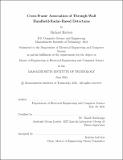Cross-Frame Association of Through-Wall Handheld-Radar-Based Detections
Author(s)
Hiebert, Michael
DownloadThesis PDF (2.193Mb)
Advisor
Ouedraogo, Raoul
Terms of use
Metadata
Show full item recordAbstract
Recent work with radar-based detection systems has demonstrated its efficacy in identifying [10], classifying [6] [8] [2] humans and animals, and even recognizing gestures [5] in low-light environments and through walls, cases where conventional vision-based systems fail. Most previous research has involved onsite (edge) gathering of data and offsite (non-edge) processing to produce detections, i.e. the experimental platforms have not been productionized nor tested live in applicable environments. Further, many of the proposed architectures rely on the specific motion paths of subjects to identify them. MIT Lincoln Laboratory’s (MITLL) Group 45 has designed a prototype portable radar system capable of producing similar radar data to that collected in the aforementioned research and then identifying individuals in-frame, solely based on vital-signs and regardless of motion. I propose a computational architecture which can incorporate some of the previous advances with tracking in computer vision to detect and identify individuals while operating on the edge under the compute and power constraints of the handheld radar system in which it will be embedded.
Date issued
2021-06Department
Massachusetts Institute of Technology. Department of Electrical Engineering and Computer SciencePublisher
Massachusetts Institute of Technology